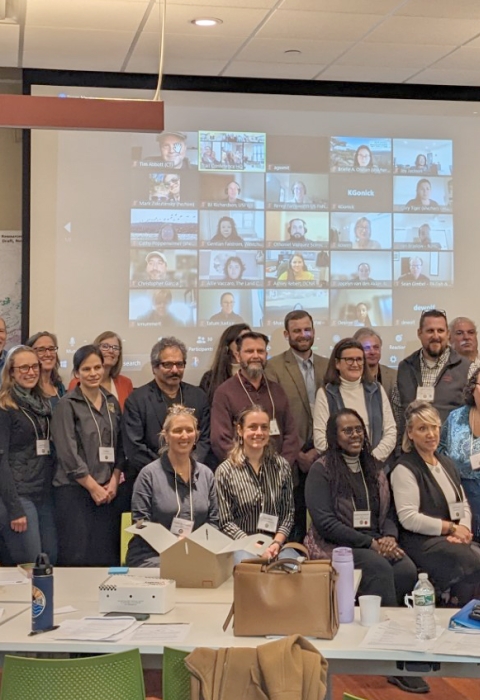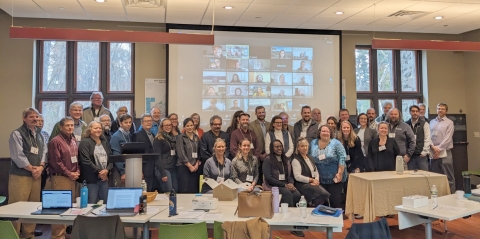Protecting natural resources within an area that spans 3.4 million acres along the Appalachian ridgeline is no small feat. In fact, it takes collaboration and innovation, and that’s exactly what was served up at the 2023 Highlands Summit in Mahwah, New Jersey.
The Summit brought together people involved in protecting land across the Highlands region, an area that stretches from northwestern Connecticut, through southern New York and northern New Jersey, and into eastern Pennsylvania. The Highlands Conservation Act was passed in 2004 to conserve natural resources in this region, founding the Highlands Conservation Act grant program. Through the dedication of conference attendees and many others, the region supports an incredible eight million recreational visitors annually while providing clean drinking water for millions of people living in the surrounding area.
“For generations, the Highlands region has been recognized for its important natural and cultural resources in such close proximity to large urban areas. It is a critically important landscape for climate resilience, connectivity and biodiversity supporting hundreds of species, including many that are listed as threatened or endangered or at-risk of being listed,” said Kyla Hastie, deputy regional director of the Service’s Northeast Region.
Summit attendees included representatives from the Service, state partners, nongovernment organizations and land trusts. They all share the vision of protecting drinking water resources for local cities and towns, creating public areas for outdoor recreation and providing habitat for wildlife.
As the act prepares to mark 20 years in 2024, Summit attendees looked to the future of the Highlands region, focusing on creating equitable access for more people. Going forward, there will likely be an emphasis on conserving land within close proximity to populated areas so that more people can reach Highlands conserved properties by walking or utilizing public transportation.
"When the HCA was put together, it was a roadmap for the next 20 years. We are actually at that point right now and looking at the next 20 years,” said Katrina Shindledecker, executive director of Hudson Highlands Land Trust. “Looking at where we are and our regional conservation partnerships, we can leverage each other's strengths and utilize what other organizations are doing."
The conference offered training about the program and Notice of Funding Opportunities. Breakout sessions allowed for valuable networking and collaboration; people shared updates and resources, learned about tools for future land acquisitions and celebrated past ones.
Announced earlier this year, the Highlands Conservation Act has been reauthorized for the next seven years. Important updates of reauthorization were discussed. States will also now have the opportunity to petition the Service to expand the existing Highlands Region boundary. Also, while state agencies must still apply for funds, counties and municipalities can now receive grant funds and hold lands through subawards.
Attendees were also able to discuss the latest scientific and GIS mapping technologies, tools that are increasingly important to land conservation. These tools allow conservationists to determine areas of the landscape that have the highest conservation value.
Each of the Highlands states celebrated their successes:
- Connecticut created the Cook, Bantam and Mt. Tom preserves in the town of Washington in Litchfield County. The Connecticut Department of Energy and Environmental Protection, in partnership with Steep Rock Association, acquired the three parcels totaling 187 acres.
- New York successfully added a 32-acre parcel in Putnam Valley to the Clarence Fahnestock Memorial State Park via a partnership with the Open Space Institute.
- New Jersey recently protected a 70-acre parcel named Rockaway Creek Preserve which includes 65 acres of forest, 1.2 miles of Category-1 stream, six acres of mapped freshwater wetlands, and wildlife habitat that supports state species of special concern.
- Pennsylvania made 30 acquisitions since the program began, conserving more than 2,200 acres across seven counties. Acquisitions included several additions to William Penn State Forest, Nockamixon State Park, French Creek State Park, Marsh Creek State Park, Nolde Forest Environmental Education Center and multiple state game lands.
The Highlands landscape is as diverse as the people who call it home. Conserving its forests, streams, lakes, and thousands of plant and animal species requires a diverse group of partners all working together to achieve common goals. Finding new areas and opportunities for people to enjoy and experience nature is increasingly important in highly urbanized areas. With funds from the Highlands Conservation Act, the Service and our partners can continue to conserve natural resources and equitable access for generations to come.






